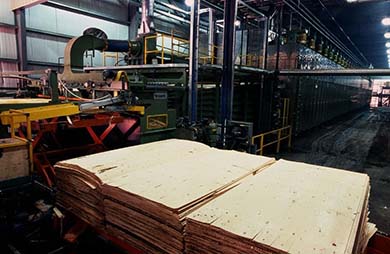Product description
Plywood is a structural wood-based panel composed of multiple layers of thin veneers. Plywood panels are manufactured for structural applications, used primarily as wall and floor sheathing in platform-frame constructed buildings such as single or multi-family housing. It can also be found in mid-rise residential and non-residential construction.

Plywood has been used in Canadian construction projects for decades and is suitable for a variety of end uses in both wet and dry service conditions.
End uses include:
- Flooring applications
- single-layer flooring
- wall and roof sheathing
- structural insulated panels
- marine applications
- webs of wood I-joists
- concrete formwork
- pallets and industrial containers
- furniture
Technical information
Thin veneers, typically 1/8 or 1/10-inch in thickness, are produced by a wide knife cutting through a rotating log on a spindle. The veneers are glued together so that the grain direction of each layer of veneer is perpendicular to that of the adjacent layers. These cross-laminated sheets of wood veneer are bonded together with a waterproof adhesive and cured under heat and pressure. This arrangement of the veneers results in superior dimensional stability, two-way strength and stiffness properties and an excellent strength-to-weight ratio.
Plywood is produced in various thicknesses and in more than 20 different appearance grades. The most commonly used thickness is 1/2-inch and the panels are typically manufactured in 4x8-foot sheets.
Plywood is highly resistant to impact damage, chemicals, and changes in temperature and relative humidity. It can be chemically treated to improve resistance to decay or to fire.